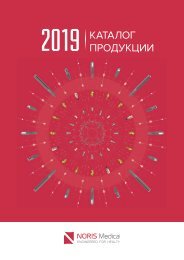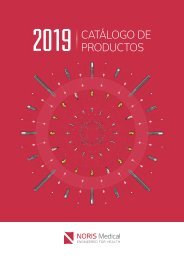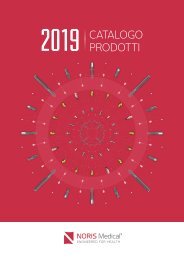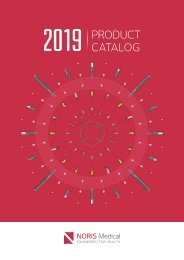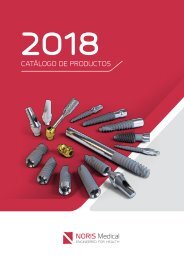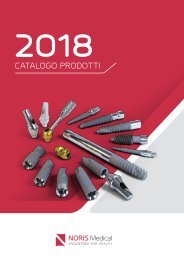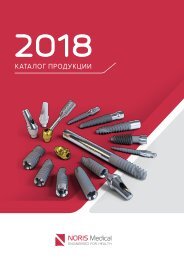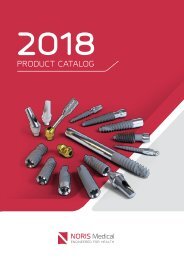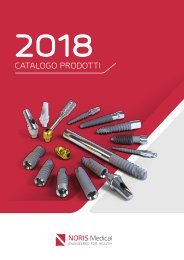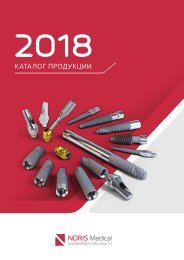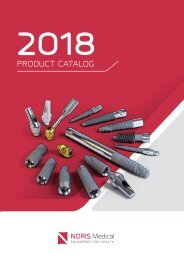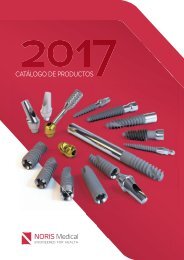Noris Medical Dental Implants Product Catalog 2017
Create successful ePaper yourself
Turn your PDF publications into a flip-book with our unique Google optimized e-Paper software.
Standards<br />
<strong>Noris</strong> <strong>Medical</strong> invests significant resources in creating an environment for the design and manufacture of its dental<br />
products. Keeping patient safety at the forefront throughout the process, <strong>Noris</strong> <strong>Medical</strong> complies with international<br />
standards for manufacturing and quality. The entire manufacturing process is monitored and recorded for total<br />
process traceability. All facilities are subjected to strict inspection procedures.<br />
• <strong>Product</strong>s carry the CE mark and meet the European <strong>Medical</strong> Device Directive (93/42/EEC).<br />
• <strong>Product</strong>s received the FDA Clearance Premarket Notification (510k) (K140440).<br />
• Meticulous quality control system is in compliance with ISO 9001:2008, EN ISO 13485:2012 and FDA QSR 21 CFR<br />
Part 820.<br />
• Facilities are subject to routine audits by international auditors.<br />
• Class 10,000 Clean Room for production.<br />
Materials & Surface Treatment<br />
Titanium alloys are known for their superior<br />
biocompatibility and tensile strength. Therefore, all <strong>Noris</strong><br />
<strong>Medical</strong> <strong>Dental</strong> <strong>Implants</strong> and Prosthetic Components<br />
are produced from Titanium Alloy Ti6Al4V (Grade 5).<br />
Macroscopic and microscopic properties of <strong>Dental</strong><br />
Implant surfaces play a major role in their osseous<br />
healing process. Roughened implant surfaces provide<br />
increased retention strength. The topography, down to<br />
the micrometer, affects the attachment and growth<br />
of bone cells.<br />
<strong>Noris</strong> <strong>Medical</strong> applies RBM (Resorbable Blast Media)<br />
technique in order to induce the sub-micro topography.<br />
The material used for RBM process is Calcium Phosphate,<br />
which is a highly resorbable and biocompatible material.<br />
Usage of Calcium Phosphate as the blasting material also<br />
eliminates the need of using strong acids for the removal<br />
of blasting material remnants.<br />
Implant surfaces that have been RBM treated are<br />
considered to be more osteoconductive. Research<br />
showed higher percentage of bone to implant contact<br />
around RBM treated implants. This finding could be<br />
especially useful in severe clinical conditions like poor<br />
bone quality and in cases of early or immediate loading.<br />
References<br />
McCrcken M. <strong>Dental</strong> implant material: Commercially pure titanium and titanium alloys. J Prosthod 1999; 8:40-43.<br />
Schwartz Z, Raz P, Zhao G, Barak Y, Tauber M, Yao H, Boyan BD. Effect of micrometer-scale roughness of the surface of Ti6Al4V pedicle<br />
screws in vitro and in vivo. J Bone Joint Surg Am. 2008; 90:2485-98.<br />
Piattelli A, Manzon L, Scarano A, Paolantonio M, Piattelli M. Histologic and histomorphometric analysis of the bone response to machined<br />
and sandblasted titanium implants: An experimental study in rabbits. Int J Oral Maxillofac <strong>Implants</strong>. 1998;13:805–810.<br />
Piattelli M, Scarano A, Quaranto M, Petrone G, Piattelli A. bone response in rabbit to machined and RBM titanium implants. J Dent Res.<br />
1999;78:1126.<br />
Piattelli M, Scarano A, Paolantonio M, Iezzi G, Petrone G, Piattelli A. Bone response to machined and resorbable blast material titanium<br />
implants: an experimental study in rabbits. J Oral Implantol. 2002;28;2-8.<br />
/ 4 / <strong>Implants</strong>



